1. Foreign direct investments in 2019
This review examines the development of foreign direct investments in 2019. The different sections of the review raise factors that affect the interpretation of the figures. The description of the statistics should also be considered when using the figures.
In 2019, direct investments both from Finland abroad and from abroad to Finland increased significantly. The value of foreign direct investments (FDI) to Finland was EUR 76.4 billion at the end of 2019. The investment stock grew by EUR 13.5 billion from 2018. At the end of the year, the value of Finland's outward FDI totalled EUR 130.4 billion, having grown by EUR 17.9 billion from the previous year. Returns on Finland’s inward FDI amounted on net to EUR 4.8 billion.
In this review, investment flows include reinvested earnings in addition to financial transactions. In the renewed database tables, reinvested earnings and dividends and interests paid to owners have been combined into the variable of returns on investments, and the flow only includes financial transactions.
1.1 Data content and purpose of use
The statistics on foreign direct investments mainly depict financial transactions between domestic and foreign units in multinational groups and the assets and liabilities they generate, as well as international corporate acquisitions. Foreign direct investments are often interpreted too simply as real investments. The 2018 review opens the data content and interpretation of the statistics more comprehensively and the netting of financial assets and liabilities according to the directional principle.
1.2 Global FDI
According to the investment report published by the United Nations Conference on Trade and Development (UNCTAD: (World Investment Report 2020), flows of global FDI grew by three per cent measured in USD in 2019. Due to exchange rate changes, the growth amounted to more in euros, just under nine per cent. The growth in investment flows particularly concerned investments in developed economies. Clearly more capital also flowed to transition economies than in the year before.
Figure 1. Global flows of direct investments in 2004 to 2019
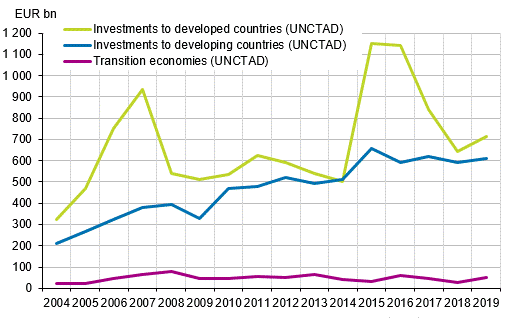
In total, global foreign direct investments amounted to EUR 1,376 billion in 2019, of which EUR 715 billion were directed at developed countries and EUR 612 billion at emerging economies. Examined by country, the USA was the largest host country of direct investments followed by China and Singapore. The largest investor countries were Japan, the USA and the Netherlands.
The investment report of the United Nations Conference on Trade and Development published in June 2020 predicts that global flows of direct investments will collapse by as much as 40 per cent between 2020 and 2021 as a result of the coronavirus pandemic. It is stressed that the projection involves a considerable degree of uncertainty. In addition to the immediate effects of the pandemic (closure of establishments and production plants, suspensions of acquisitions and investments that create new activities, etc.), the report predicts that FDI flows will decline in the medium term as the economic downturn first suspends, and eventually even fully cancels, investment projects. In addition, permanent changes are anticipated in the long term as companies aim to reduce their dependency on global supply chains and increase their self-sufficiency by moving production closer to their home country.
1.3 Finland’s flows of FDI
In 2019, Finland's inward FDI returned to positive levels again after 2018, as FDIs to Finland totalled EUR 12.2 billion on net including reinvested earnings. Examined by country group, most of the investments to Finland came from the EU area and Eastern Asia. Finland’s outward FDI, in turn, fell from the level of 2018 as EUR 4.3 billion on net were made as direct investments abroad, including reinvested earnings. Examined by country group, most investments were made to the EU area and other European countries. Finland’s inward and outward FDI are examined in more detail in Sections 1.4 and 1.5.
Figure 2. Flows of FDI in 2004 to 2019
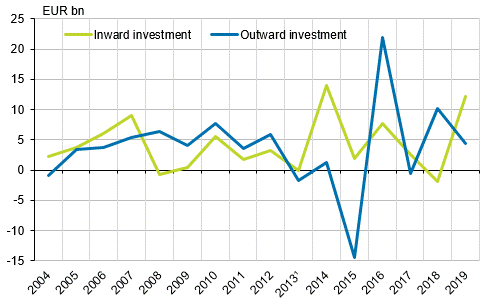
�) Starting from 2013, the figures are not fully comparable with those for 2004 to 2012 due to changes in the international statistical standard.
1.4 Finland's inward FDI
In 2019, a total of EUR 12.2 billion direct investments were made to Finland on net, which is the biggest amount since 2014. During 2019, EUR 10.1 billion flowed to Finland as financial transactions. Reinvested earnings amounted to EUR 2.1 billion, which describes the difference between the income of foreign-owned Finnish companies and dividends paid abroad.
In 2019, investments in equity-based items amounted to EUR 4.2 billion, of which the share of both reinvested earnings and financial transactions was EUR 2.1 billion. Investments flowed to debt-based items to the tune of EUR 8.0 billion, that is, a considerable share of foreign investments to Finland were made in the form of loans.
At the end of 2019, the value of FDIs to Finland from abroad totalled EUR 76.4 billion, of which equity accounted for EUR 62.2 billion and the value of debt capital for EUR 14.2 billion. For listed companies, the value of equity capital is recognised at market value and for other enterprises at book value. In connection with corporate acquisitions, the value of equity is valued based on the market value and the actual transaction price is utilised in determining the market value.
During 2019, the total value of FDI grew by a total of EUR 13.5 billion, of which debt-based items accounted for EUR 8.4 billion and equity-based items for EUR 5.1 billion. In addition to financial transactions and reinvested earnings, the growth of the investment stock includes price changes and classification changes caused by other than exchange rates, to the value of EUR 1.3 billion. Classification changes refer to changes in the value of the stock of financial assets or liabilities that are not caused by cross-border financial transactions or other changes. Classification changes include, for example, changes in the value of the stock of assets or liabilities due to a cross-border change of the enterprise's domicile and changes caused by enterprise reorganisations, in which the enterprise group organises its internal ownership structure.
Table 1. Finland's inward FDI, EUR billion.
| Total | Equity | Debt | |
| Stock of investments 31 Dec 2018 | 62,9 | 57,1 | 5,8 |
| Financial transactions excl. re-invested earnings | 10,1 | 2,1 | 8,0 |
| Re-invested earnings | 2,1 | 2,1 | 0,0 |
| Changes in the exchange rates | 0,0 | 0,0 | 0,0 |
| Other valuation adjustments | 1,3 | 0,9 | 0,4 |
| Stock of investments 31 Dec 2019 | 76,4 | 62,2 | 14,2 |
Examined by country, direct investments have been made to Finland particularly from Sweden (28% of the investment stock), Luxembourg (15%), the Netherlands (15%), Norway (6%) and Denmark (5%). Examined by country group, investments to Finland mainly come from the EU area, whose combined share of the investment stock was 82 per cent in 2019. The share of euro area countries was 45 per cent of the investment portfolio. The shares presented here were calculated according to the immediate investor country. In fact, investments are often managed through an affiliate abroad, in which case the ultimate controlling investor is located in some other country. These figures calculated according to the ultimate investing country are examined in more detail in Section 1.7 of this review.
Figure 3. Direct investments to Finland according to the immediate investor country, stock of investments on 31 December
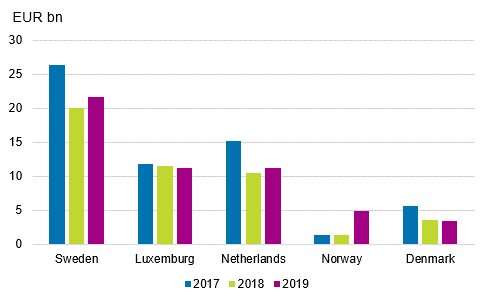
Examined by industry, Finland's inward FDI is directed to financial and insurance enterprises (18%), information and communication enterprises (13%) and real estate enterprises (9%). In manufacturing, most investments have been made in metal industry enterprises (12%) and chemical industry enterprises (11%). The industry of the investment is determined based on the industry of the domestic unit. Then, the share of financing activities is increased by arrangements where a Finnish manufacturing enterprise, for example, is managed from abroad through a holding company classified in the financial sector and established in Finland for that purpose.
In 2019, Finland's inward FDI generated returns of EUR 7.4 billion in total for foreign investors. Dividends amounting to EUR 4.9 billion and interests to EUR 0.5 billion were recorded in returns. In addition, reinvested earnings amounted to EUR 2.1 billion. They describe the difference between the returns accrued on equity and paid to owners in a given year. The reinvested earnings of EUR 2.1 billion are also recorded in Finland’s inward FDI (see Table 1).
Returns generated by foreign investors relative to the value of the investment portfolio decreased slightly from the year before. In 2019, the returns amounted to 9.7 per cent, having been 10.5 cent in 2018. Examined by country, most returns on direct investments in Finland were generated to Sweden (EUR 3.8 billion), the Netherlands (1.3) and Luxembourg (1.0).
Figure 4. Rate of return of Finland's inward FDI in 2004 to 2019
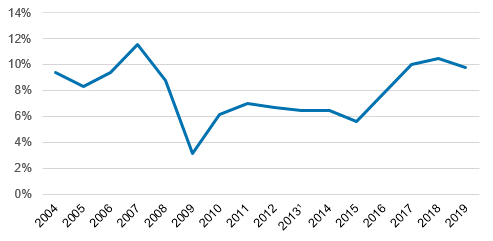
�) Starting from 2013, the figures are not fully comparable with those for 2004 to 2012 due to changes in the international statistical standard.
1.5 Finland's outward FDI
The net amount of Finland's outward FDI was EUR 4.3 billion, which is mainly explained by the growth in reinvested earnings from EUR 0.1 billion in 2018 to EUR 3.8 billion. Over the year, Finnish companies’ foreign affiliates and associative companies thus generated EUR 3.8 billion more returns than dividends were paid to Finland. During 2019, the flow of financial transactions on net from Finland abroad amounted to EUR 0.6 billion. Equity investments decreased by EUR 0.5 billion and debt investments increased by EUR 1.1 billion.
At the end of 2019, the value of the stock of outward FDI was EUR 130.4 billion, of which equity accounted for EUR 132.0 billion and the value of debt capital for EUR -1.6 billion. In addition to reinvested earnings, the increase in the value of the investment stock by EUR 17.9 billion is explained even more by other valuation changes. These include price changes and classification changes caused by other than exchange rates, the content of which is described in more detail in Section 1.4 of this review.
Table 2. Finland's outward FDI, EUR billion
| Total | Equity | Debt | |
| Stock of investments 31 Dec 2018 | 112,5 | 116,1 | -3,6 |
| Financial transactions excl. re-invested earnings | 0,6 | -0,5 | 1,1 |
| Re-invested earnings | 3,8 | 3,8 | 0,0 |
| Changes in the exchange rates | -0,3 | -0,3 | 0,0 |
| Other valuation adjustments | 13,8 | 13,0 | 0,8 |
| Stock of investments 31 Dec 2019 | 130,4 | 132,0 | -1,6 |
*) Due to rounding differences, the investment stock at the end of 2018 and changes during 2019 are not summed up evenly at the end of 2019 for equity and debt-based items.
Examined by country, FDI from Finland is especially directed to the Netherlands (24% of the investment stock), Sweden (20%), Ireland (16%), Denmark (5%), and Norway (5%). Examined by country group, investments are mainly directed to the EU area, whose combined share of the investment portfolio was 80 per cent at the end of 2019. The share of the countries belonging to the euro area in the stock of outward FDI was 51 per cent.
Figure 5. Finland's outward FDI by immediate investor country, stock of investments on 31 December, EUR billion
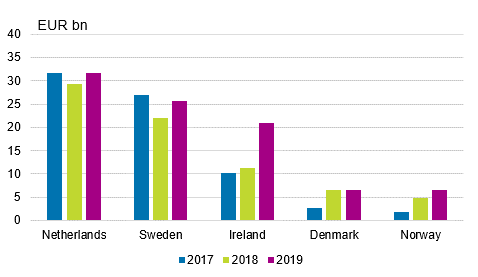
The shares above were calculated according to the country of the immediate investment target. There are no data available on outward FDI according to the country of the ultimate investment target, so it is not possible to give a more exact specification of the final investment target. However, most of the investments directed abroad are connected to the management of a global enterprise or its part and the actual production activity is located in another investing country.
The industry of foreign direct investments from Finland is determined based on the industry of the Finnish investor. Examined by industry, outward FDI is held particularly by enterprises in the metal industry (24% of the investment stock of all industries), financial and insurance activities (20%) and the forest industry (10%).
In 2019, Finland's returns from outward FDI totalled a record amount of EUR 12.2 billion. Of the returns, EUR 8.0 billion were dividends, EUR 0.3 billion interests and EUR 3.8 billion reinvested earnings. Dividends and interests were on level with 2018, but reinvested earnings grew by EUR 3.7 billion from one year ago. The reinvested earnings of EUR 3.8 billion are also recorded in Finland’s outward FDI (see Table 2).
Returns gained by Finland relative to the value of the FDI stock grew from the previous year, as the rate of return rose to 9.4 from 7.7 per cent in 2018. Examined by country, Finland generated most returns in euros from Sweden (EUR 4.0 billion), the Netherlands (2.4 billion) and Singapore (1.0 billion).
Figure 6. Rate of return of Finland's outward FDI in 2004 to 2019
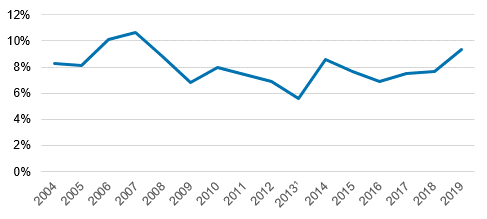
�) Starting from 2013, the figures are not fully comparable with those for 2004 to 2012 due to changes in the international statistical standard
1.6 Direct investments in the balance of payments
The figures for direct investments according to the directional principle presented in this review differ from the gross figures presented in the statistics on balance of payments and international investment position. The differing statistical method of balance of payments is discussed more in Section 2.2 of the review for the statistical reference year 2013.
At the end of 2019, the value of Finland's inward FDI stock was EUR 76.4 billion and that of outward FDI stock was EUR 130.4 billion. In 2019, the value of the stock of both inward and outward FDI rose. The net international investment position of direct investments strengthened as the value of the stock of outward FDI grew more than that of inward FDI. Foreign direct investment assets on net grew to EUR 54.0 billion from the previous year's EUR 49.6 billion. In particular, direct investments improve the net international investment position of the enterprise sector. Net international position connected to direct investments is the same in the statistics on balance of payments and international investment position, although the gross figures of balance of payments differ from the figures presented here according to the directional principle.
Figure 7. Foreign direct investments in 2004 to 2019
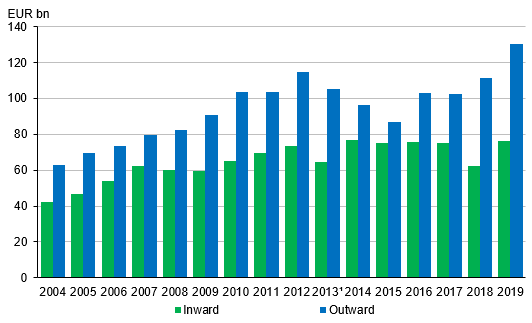
�) Starting from 2013, the figures are not fully comparable with those for 2004 to 2012 due to changes in the international statistical standard.
In 2019, returns on inward FDI amounted in total to EUR 12.2 billion and on outward FDI to EUR 7.4 billion. This property income is recorded in the primary income item of Finland's current account and its net effect on Finland's current account was EUR 4.8 billion in 2019. Net returns from direct investments grew from the previous year, which was primarily due to an increase in returns paid to Finland. Figure 8 shows that returns connected to direct investments have improved Finland's current account throughout the reference period 2004 to 2019. The net effect of returns from foreign direct investments on the primary income of the current account has fluctuated between EUR 0.4 billion and EUR 4.8 billion.
Figure 8. Returns on FDI in 2004 to 2019
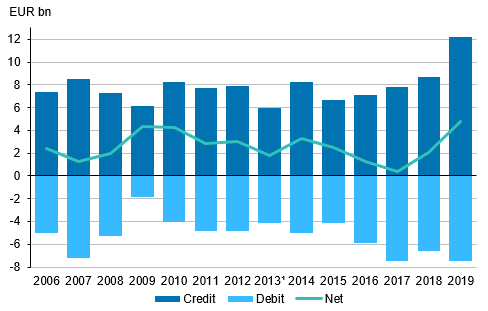
�) Starting from 2013, the figures are not fully comparable with those for 2004 to 2012 due to changes in the international statistical standard
1.7 Investments according to the ultimate investing country
Direct investments have conventionally been examined only on the basis of the immediate investor country. The new statistical standards and data collected on a more detailed level than before also enable country-specific analyses of direct investments by the ultimate investing country starting from 2013. The ultimate direct investor here refers to the one that is topmost in the ownership chain of the foreign direct investor. The ultimate direct investor is not controlled by any other unit and it can also be a domestic unit.
Figure 9 shows that direct investments to Finland have been made clearly more from Sweden, the Netherlands and Luxembourg if investments are viewed according to the immediate investor country than when the investments are examined according to the ultimate investing country. This indicates that these investments are managed through an enterprise located in these countries, although the actual investor is elsewhere. The opposite is true for the United States, Germany and China. This means that a clearly larger share of FDI into Finland is managed in these countries than made immediately into Finland. When examined by the ultimate direct investor, the share of Finland should also be considered. This is because domestic enterprises own domestic affiliates through their foreign affiliates.
Figure 9. Foreign direct investments to Finland according to the immediate and ultimate investing country, stock of investments on 31 December 2019, EUR billion (The figure was corrected on 16 October 2020)
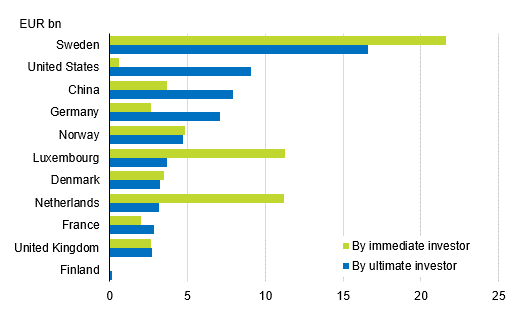
1.8 Investments from Finland, according to the country of the highest controlling owner
It is not possible to compile statistics on Finland's outward FDI by ultimate investing country with the help of the available data sources. However, by examining the ownership chains of enterprises that have made foreign investments from Finland we can examine what proportion of Finland's outward FDI has been made by enterprises that are under Finnish control. The limitation of such an examination is also that it covers only the ownership chain of units in corporate form. For example, the actual owners of a parent company registered in Luxembourg can be Finnish private citizens.
In 2019, the value of Finland's outward FDI was EUR 130.4 billion, of which 92 per cent were held by enterprises under Finnish control. The United States (2%) and Sweden (1%) were the most significant ultimate investing countries outside Finland. Therefore, Finland cannot be regarded as a significant pass-through country for direct investments.
Source: Foreign direct investments 2019, Statistics Finland
Inquiries: Petri Kinnarinen 029 551 3428, balanceofpayments@stat.fi
Head of Department in charge: Mari Yl�-Jarkko
Updated 30.09.2020
Official Statistics of Finland (OSF):
Foreign direct investments [e-publication].
ISSN=2342-351X. 2019,
1. Foreign direct investments in 2019
. Helsinki: Statistics Finland [referred: 30.8.2025].
Access method: http://stat.fi/til/ssij/2019/ssij_2019_2020-09-30_kat_001_en.html

